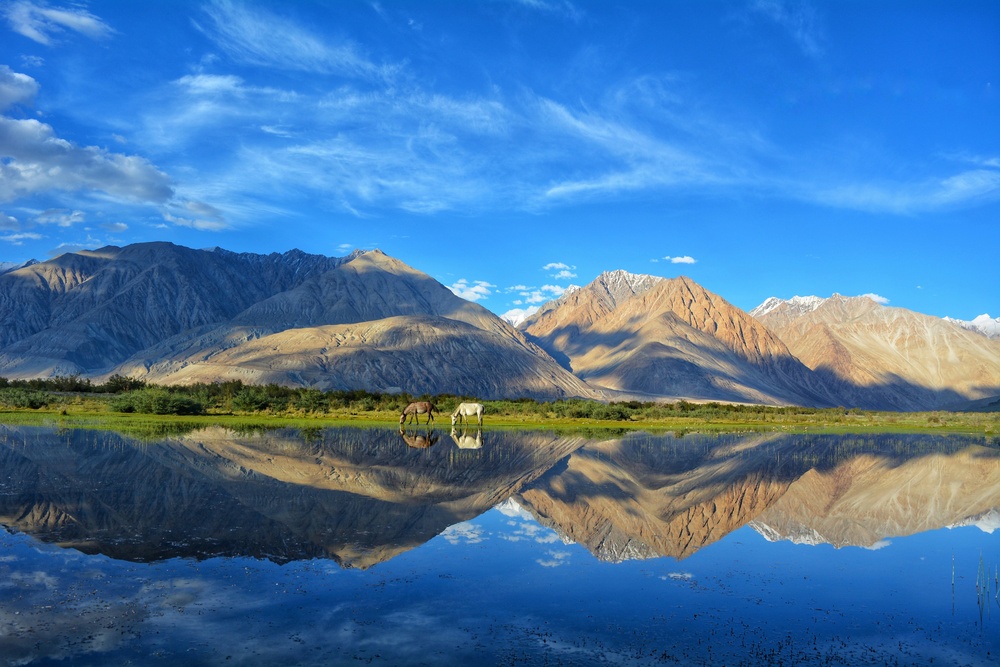Ladakh, often referred to as “The Land of High Passes,” is a dream destination for travelers who seek raw natural beauty, cultural depth, and high-altitude adventure. With its dramatic landscapes, snow-capped mountains, ancient monasteries, and crystal-clear lakes, Ladakh offers a unique travel experience unlike any other place in India. Whether you’re an adventurer, nature lover, spiritual seeker, or cultural explorer, Ladakh tourism has something extraordinary for everyone.
In this article, we explore the top attractions, experiences, and essential information that make Ladakh one of the most unforgettable destinations in the world.
Why Ladakh Tourism Is So Special
Ladakh is located in the northernmost region of India and was formerly part of the state of Jammu and Kashmir. Now a separate union territory, Ladakh is known for its stark beauty, clear skies, and distinct Tibetan Buddhist culture. The high-altitude desert, cradled by the Himalayas and Karakoram ranges, features some of the most breathtaking landscapes on earth.
Travelers come to Ladakh to experience:
- Tranquil monasteries perched on cliffs
- Adventure activities like trekking, biking, and river rafting
- Remote villages preserving centuries-old traditions
- Surreal lakes reflecting the sky
- Spiritual retreats amidst the mountains
Top Places to Visit in Ladakh Tourism
1. Leh – The Gateway to Ladakh
Leh, the capital of Ladakh, is the first stop for most travelers. Located at an altitude of over 11,000 feet, it’s a town filled with Tibetan culture, bustling markets, and historical sites.
Must-visit attractions in Leh:
- Leh Palace: A 17th-century structure resembling Potala Palace in Lhasa.
- Shanti Stupa: A white-domed stupa offering panoramic views of Leh and the surrounding mountains.
- Tsemo Fort: A hilltop structure with sweeping views of the valley.
- Leh Market: A lively place to shop for woolens, handicrafts, and souvenirs.
2. Pangong Tso – The Iconic Lake
Located at over 14,000 feet, Pangong Lake is one of the most famous attractions in Ladakh tourism. Its crystal-clear blue waters change color with the sunlight, making it a favorite among photographers and filmmakers.
- The lake stretches into Tibet, with two-thirds of it lying outside India.
- Camping near Pangong Lake under the stars is a magical experience.
3. Nubra Valley – Desert in the Mountains
Known for its sand dunes, double-humped Bactrian camels, and the Shyok River, Nubra Valley offers an unexpected desert landscape amidst snow-clad mountains.
Highlights:
- Diskit Monastery: Home to a giant Maitreya Buddha statue overlooking the valley.
- Hunder Sand Dunes: A surreal experience with camel rides in a high-altitude desert.
- Turtuk Village: A remote and culturally rich village near the India-Pakistan border.
4. Tso Moriri – The Lesser-Known Beauty
If you’re looking for serenity and fewer crowds, Tso Moriri Lake is a must-visit. Located in the Changthang Plateau, it is surrounded by snow-capped peaks and supports diverse birdlife.
- A UNESCO designated wetland reserve, it is ideal for nature lovers and photographers.
- The nearby Korzok Village offers homestays and a peek into the nomadic lifestyle.
5. Lamayuru – The Moonland of Ladakh
Lamayuru is famous for its lunar-like landscapes and ancient monastery, one of the oldest in Ladakh.
Lamayuru Monastery is perched atop a hill, with colorful prayer flags fluttering in the breeze. The area’s unique terrain has earned it the nickname “Moonland of Ladakh.”
6. Zanskar Valley – Remote and Rugged
For those looking to explore offbeat Ladakh, Zanskar Valley is a hidden gem. Accessible by road only during summer, it offers spectacular trekking routes and remote village life.
- Chadar Trek on the frozen Zanskar River (in winter) is one of India’s most challenging and iconic treks.
- The valley is dotted with monasteries like Phugtal and Karsha, accessible by foot or horse.
Cultural and Spiritual Side of Ladakh Tourism
Ladakh’s culture is deeply influenced by Tibetan Buddhism. The region is home to some of the most beautiful and spiritually significant monasteries in the world.
- Hemis Monastery: The largest and wealthiest monastery, known for its annual Hemis Festival.
- Thiksey Monastery: A magnificent hilltop structure with 12 stories and an impressive statue of Maitreya Buddha.
- Alchi Monastery: Known for its ancient Indo-Tibetan wall paintings dating back to the 11th century.
Monastic festivals, rituals, and the sound of chanting monks create a peaceful atmosphere that attracts spiritual seekers from around the world.
Adventure Activities in Ladakh
Ladakh tourism is not complete without its thrilling adventure opportunities:
- Trekking: Popular treks include Markha Valley, Stok Kangri, and Snow Leopard Trail.
- Biking: Riding a Royal Enfield across high mountain passes like Khardung La (one of the highest motorable roads in the world) is a dream for bikers.
- River Rafting: The Zanskar and Indus Rivers offer white-water rafting with amazing views.
- Camping: Camp near rivers, lakes, or in valleys under a sky full of stars.
Best Time to Visit Ladakh
- Summer (May to September): Ideal for sightseeing, road trips, and treks.
- Winter (November to February): Best for snow lovers and adventure seekers, especially the Chadar Trek.
- Monsoon is minimal, making even July and August good months for Ladakh tourism.
How to Reach Ladakh
- By Air: Leh Airport (Kushok Bakula Rimpochee Airport) is well-connected to Delhi and major Indian cities.
- By Road:
- Srinagar-Leh Highway: Opens from late April to October.
- Manali-Leh Highway: Open from June to September; a scenic and adventurous route.
- Srinagar-Leh Highway: Opens from late April to October.
- By Bike or Car: Road trips to Ladakh are immensely popular among thrill-seekers.
Travel Tips for Ladakh Tourism
- Acclimatize properly after arrival to avoid altitude sickness.
- Drink plenty of water and avoid alcohol for the first 24–48 hours.
- Carry warm clothing even in summer, as temperatures can drop drastically at night.
- Mobile networks are limited. BSNL and Jio work best in Leh.
- Inner line permits are required for certain areas (available online or in Leh).
Conclusion
Ladakh tourism offers a rare blend of raw Himalayan beauty, peaceful spirituality, and thrilling adventure. Every village, monastery, lake, and mountain pass tells a story—of nature, resilience, and harmony. Whether you’re gazing at Pangong Lake, riding across Khardung La, or meditating in a centuries-old monastery, Ladakh leaves you breathless in the best way possible.
If you’re yearning for a journey that touches your soul and challenges your spirit, Ladakh awaits with open arms and towering peaks.





